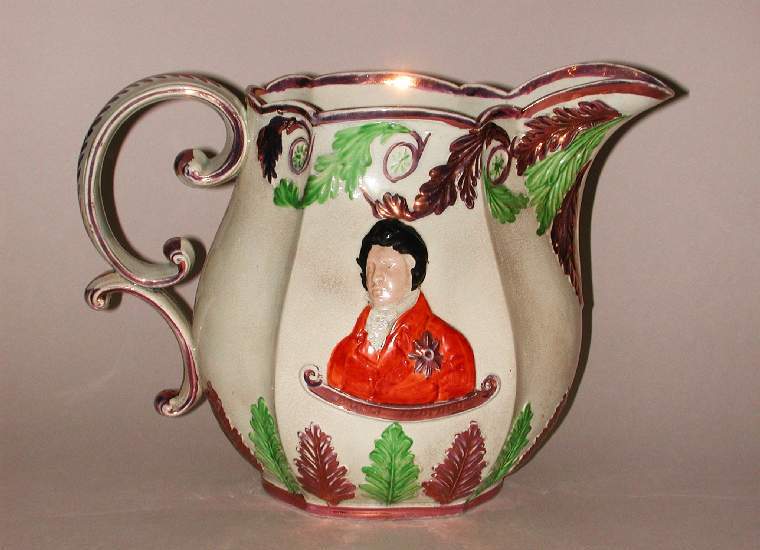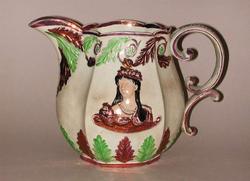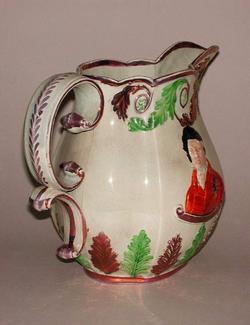Current Location: In storage
Titles
Charlotte & Leopold Jug
Maker(s)
Factory:
Unidentified factory
(Probably)
Entities
Categories
Description
White earthenware, moulded, glazed and painted with copper lustre and green, black and red enamels.
Six-sided, oval section, relief-moulded jug with a double-scroll handle and scalloped rim. On one side, a relief bust of Princess Charlotte, wearing pearls and a crown; on the other, Prince Leopold, wearing a red coat and star of office. Under each bust is a banner with the name inscribed. A row of relief-moulded standing leaves runs around the foot and a garland of similar leaves scrolls around the rim and under the lip. The rims of the jug and the edge of the handle, Charlotte’s dress and crown, Leopold’s star and alternate leaves are lustred; a strip of stylised lustre leaves runs down the outside of the handle. The glaze has a greenish-blue tinge. The underside is recessed and glazed.
Notes
History note: Bought from Mr Earwaker, Staffa, Highcliff, near Bournemouth, for ten guineas (ten pounds ten shillings) on 18th September, 1919, by Dr J.W.L. Glaisher, Trinity College, Cambridge. The vendor had bought the jug near Burton.
Legal notes
Dr. J.W.L. Glaisher Bequest, 1928
Measurements and weight
Depth: 17 cm
Height: 21.9 cm
Width: 28.5 cm
Acquisition and important dates
Method of acquisition: Bequeathed
(1928)
by
Glaisher, J. W. L., Dr
Dating
George III
19th Century, Early
1816
CE
-
1817
CE
Note
English lustreware was first produced commercially c.1805 and popular throughout the first half of the 19th Century. Staffordshire potters were the first and largest producers, though similar wares were also made in other regions and pink lustreware is often particularly associated with Sunderland. Potters used minute amounts of gold to produce copper, gold, pink or purple lustre, depending on the type of clay, lustre formula, number of layers and firing temperature; platinum was used to mimic silver. Most lustreware was made for everyday use, and factory markings are rare. Oval section moulded and lustred jugs were made by many Staffordshire potteries in the 1820s, and also in other areas. The six sided, scalloped rim shape of this jug perhaps indicates the form was taken from a metal jug.
Princess Charlotte, the only child of the Prince Regent (later George IV) and Caroline of Brunswick. She was married to Prince Leopold of Saxe-Coburg- Saarlfeld in May 1816, but died following childbirth only a short time later, in November 1817, at the age of 21.
People, subjects and objects depicted
Components of the work
Decoration
composed of
lustre
( copper)
enamels
( green, black and red)
lead-glaze
Materials used in production
White earthenware
Techniques used in production
Moulding
: Moulded earthenware, glazed, lustred and painted with enamels.
Inscription or legends present
- Text: No.3839. Large jug decorated in green and copper lustre with raised medallions of Princess Charlotte and Prince Leopold. b. near Bournemouth September 18th 1919.
- Location: Underside of base
- Method of creation: Rectangular paper label handwritten in black ink
- Type: Label
References and bibliographic entries
Identification numbers
Accession number: C.1123-1928
Primary reference Number: 71382
Old objerct number: 3839
Stable URI
Audit data
Created: Saturday 6 August 2011
Updated: Tuesday 30 April 2024
Last processed: Tuesday 15 July 2025
Associated departments & institutions
Owner or interested party:
The Fitzwilliam Museum
Associated department:
Applied Arts








